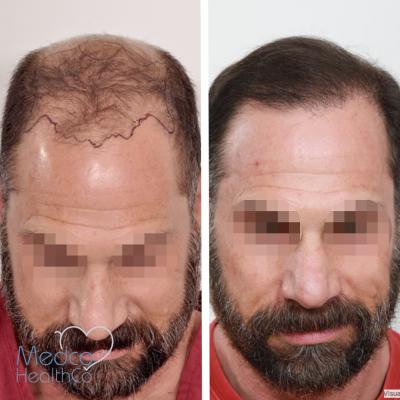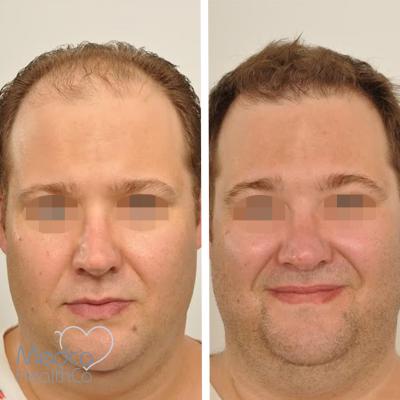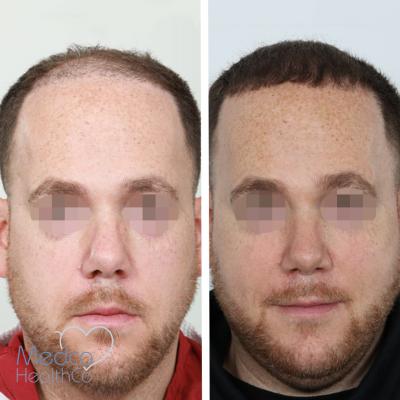FUE Technique Hair Transplant
Hair Transplant Turkey clinics
Our hair transplant clinic in Turkey employs the latest cutting edge hair restoration techniques to deliver the best possible results. Our dedicated team offers years of hands-on experience to confer effective and real results to our local and international patients.
We take pride in keeping up with the latest hair restoration techniques such as PRP, FUE and DHI hair transplant Turkey. We are committed to giving our patients professional assurance in a friendly and relaxing environment.
Procedure
FUE METHOD
For those patients who are suitable candidates for Hair Transplant surgery, Follicular Unit Extraction (FUE) is the most advanced and recently used technique where the procedure is about taking hair from the sides and the back of your head (which is immune to hair loss) to the areas of your head where you are facing hair loss. Hair Transplant Surgery is a permanent solution to your hair loss, the hair that is transplanted will not be affected by the balding process and will therefore be on your head for the rest of your life.
FUE is minimally invasive method of Hair Transplant where individual follicular units are removed directly from donor area without slits and sutures. The main advantage of FUE method is that it is a method without leaving any scars on the donor area. The surgeon extracts each graft separately with a specialized punch that is 0.75-1.0 mm in diameter and therefore leaves no scars.
In cases where the donor area has insufficient stock for a full strip transplant, the FUE method allows harvesting of additional grafts from different parts of body as well (chest, feet, back, etc.)
At our clinic we are able to transplant up to 5,000 grafts with FUE method in one session which lasts around 6-8 hours. In cases of poor donor supply at occipital area, BHT (Body Hair Transplantation) allows harvesting of additional grafts from different parts of the body (chest, beard, legs and etc.). Body Hair Transplantation is exactly the same FUE method when individual follicular units are extracted from body. However the results are not as good as the one which is used hair from head area. There is a risk of leaving permanent scars when the hair is extracted from body part such as chest, beard etc.
Phase 1: Determination and Drawing of the Hairline
After the blood test procedure and getting ready, it comes to one of the most fundamental phase of a Hair Transplant. When designing a hairline there are many ways to find out the most appropriate one.
We usually use the central anterior point. This midline point is the lowest part of the anterior hairline and defines how the remainder of the hairline will be positioned. In short, the lowest acceptable point should be situated at the junction of where the horizontal scalp intersects the vertical forehead at a 45 degree juncture. Any hair transplanted lower than this point can look unnatural since it would be situated on the forehead.
However, this basic calculation is not a rule of thumb and adjustments and corrections can be made considering patient’s age, facial shape, or else with the consent of the patient.
Phase 2: Preparation of Donor Area and Implementation of Local Anesthesia
You are usually advised to wash your hair before coming to the hospital. After the hair line drawing, your hair will be shortened to 1-2 mm. length. In some cases antiseptic liquids such as Betadine might be used to paint donor area. Then an injection of local anesthesia is applied to the patient. You will not feel any pain during surgery.
Phase 3: Harvesting the Hair Grafts
Now, you are ready for the hair follicles extraction, in another name harvesting the hair grafts. Surgeon will use micro motor punch to extract the follicles from your scalp. Micro motor has special punches in the length of 0.7-1.0 mm chosen depending on hair type and quality.
The use of the FUE method is recommended for II–V Norwood classes. FUE is also highly suited to post-traumatic and post-burn scars as well as the restoration of eyebrows.
FEMALE HAIR TRANSPLANTATION
Women experience baldness in different patterns than men. However, female baldness can often be treated with the same techniques and with excellent results. Nutrition and hormonal imbalance are more likely to be factors in thinning hair among women. Blood tests will usually be necessary to evaluate these possibilities. Women who have hair loss in the Ludwig patterns usually maintain a good hairline. The hair behind the hairline gradually miniaturizes then becomes sparse. Usually the hair loss occurs at times of hormonal change such as childbirth or menopause. It is uncommon for women to thin beyond a Ludwig’s class II and very rare for complete baldness to occur. Christmas Tree Pattern may include the hairline. Often the hair loss accelerates in the early twenties and progresses over time. The hair on the back of the head retains its original density and can be used to create follicular unit hair transplants. Transplants are placed throughout areas of thinning hair.
Balding in women can occur in various patterns.
- Gradual pattern thinning throughout the top of the head behind the hairline. (Ludwig’s Pattern I, II, III).
- Gradual thinning in one of the male patterns, rarely beyond IV.
- Christmas Tree pattern
- Diffuse alopecia (DA) in which the hair thins throughout the entire scalp. Women who have DA are not suitable candidates for hair transplantation. There is not sufficient donor hair to accomplish meaningful restoration. Fortunately, most women with hair loss fall into the other two groups and are treatable.
The transplant surgery done in female is similar to that of male and basically there is no difference. The method used in the women transplant is the FUE method. This method involves the principle extracting many follicular units from donor area and transplanting into recipient area.
The follicular units or in other words grafts contain one to three hairs in a single unit. Different sizes of follicular units are used in the Hair Transplant for women. Hair grafts with one hair is generally placed in the front in an unusual pattern along the hairline, and the graft units with two, three and four hairs are placed behind the one hair follicular unit in order to create more dense hair look. The Hair Transplant using the above procedure makes the transplanted hair look undetectable. Since this method is the advanced method it always requires good training.
After surgery procedures are not at all complicated. Some doctors allow the female patient to be free from using bandages. However we usually advise bandages for the first 24 hours. Medication is given to reduce the risk of swelling for the first three days after the surgery. Pain reducing pills are also used to decrease discomfort when needed. The patients who will undergo the hair transplant for women are advised to come to the hospital as having their hair shampooed and combed.
Hair transplant techniques in Turkey
FUE hair transplant Turkey technique
In a follicular unit extraction transplantation technique, follicles are selected individually from the back side of the head and manually transplanted to the recipient area (hair loss area) to mimic the orientation of natural hair.
FUE hair restoration method has a shorter healing time and much less scarring as opposed to the strip method—follicular unit transplantation (FUT). Follicular unit transplantation involves extracting a small tissue strip, in which small groups of follicular units are harvested and then implanted in the balding area.
FUE is an innovative hair transplant method that is purposefully designed to avoid the common risks associated with follicular unit transplantation.
FUE eliminates the need for any strip incisions, as it employs a special instrument, which functions as a punch to create a small circular incision around the grafts. This allows the hair restoration surgeon in Turkey to directly extract hair follicles from the donor area.
This technique demands more meticulous precision and artistic skill—because, without proper care, this can lead to donor graft being wasted. That’s why follicular unit extraction (FUE) is the most used—and preferred—hair restoration method in Turkey. FUE also makes for the possibility of graft harvesting from other areas of the body possible.
DHI Hair Transplant Turkey
In DHI hair transplant Turkey procedure, hair follicles are inserted into the recipient area one by one directly. Each hair follicle is implanted in a particular angle, orientation and depth, with the help of a DHI patented device, known as the DHI implanter, making for natural results and maximum hair density.
Hair transplant recovery & results
Hair transplant surgery is a simple, straightforward procedure—and so its recovery is uneventful and free of complications. That being said, patients must follow the doctor’s post-op instructions to ensure a smooth recovery.
You should be able to return to work and most routine activities the day after the procedure. You should avoid strenuous exercises and heavy lifting for the first 7 to 15 days after your hair transplant surgery.
Some crusts may appear at the base of the grafts. Most transplanted hairs will fall in the first 2 to 4 weeks after the surgery—however, the follicles will remain. You will be able to see the new hair grow after 3-5 months—and will continue to grow over 12 months after your surgery.
Hair transplant Turkey price
When it comes to traveling abroad for hair transplant surgery, the cost is the most decisive factor. Turkey is an affordable hair transplant destination particularly for UK patients due to a number of favorable factors.
The lower cost of living, the high exchange rate of the English Pound to the Turkish Lira and the country’s accessible geographic location are all influencing factors that determine the price of hair transplant surgery in Turkey.
UK patients traveling for hair transplant surgery in Turkey are expected to save up to 70 percent on their treatment. We offer all-inclusive hair transplant packages that comprise the treatment cost, hotel accommodation, transfers, interpreter and a patient host.





